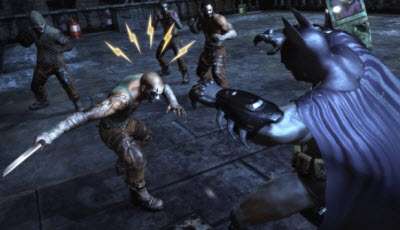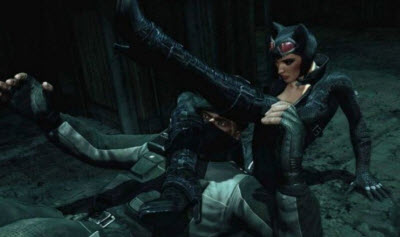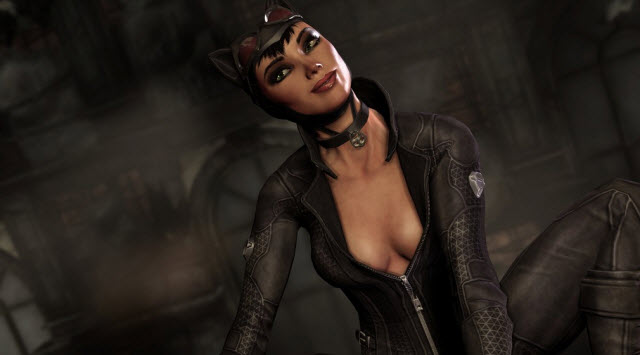
Editor’s note: This review contains minor spoilers.
For a game that was officially announced shortly after the release of its award-winning predecessor, Batman: Arkham City has turned out to be a phenomenal accomplishment for all involved. Game developer Rocksteady Studios has unequivocally delivered the greatest Batman game of all-time, and arguably the greatest comic book-inspired game as well, a notch they’ve had on their belt once before.But honestly that’s not nearly as prestigious an achievement as it should be. With as far as the medium has come, Batman: Arkham City should be par for the course, not the exception to the rule. So while it is a great game, and it outright shames what every other studio is doing with their superhero licenses, it is not quite perfect either.
Batman: Arkham City is one of the candidates for blockbuster status in a very crowded fall selling season for the video game industry, and that’s very important for its publisher, Warner Bros. Interactive Entertainment, which is trying to build the same reputation in games as it has for movies.
Picking up a year after the events of the predecessor game Batman: Arkham Asylum, former warden Quincy Sharpe has taken the credit for stopping The Joker. Sharpe uses that as a springboard to become mayor of Gotham City. He selects a large section of the Gotham slums and converts them into the titular detention city, now housing prisoners from both Arkham Asylum and Blackgate Penitentiary. If that seems like a ludicrous concept, it quite bluntly is, and part of Batman: Arkham City’s writing addresses that without ever truly justifying it. Hugo Strange, a prestigious psychiatrist, is put in charge of Arkham City, and arrests Bruce Wayne during a public appearance at a rally against the existence of the open-air prison. That is how Batman ends up in Arkham City, and so the drama and mystery begins to unfold.
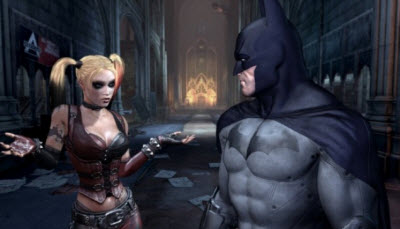 Batman: Arkham City was penned by Paul Dini, best known for his work on Batman: The Animated Series, Batman: Arkham Asylum, and perhaps most importantly of all, the creation of Harley Quinn. He is no stranger to presenting the Dark Knight’s story in the darkest and most believable way this side of Christopher Nolan, but there’s something not quite right with Batman: Arkham City. The first major dialogue sequence of the game involves Two-Face and Catwoman. In it, they exchange cheesy one-liners, but the climax comes when Catwoman teases, “Aw, no gun, Harv?” to which Two-Face replies, “Two guns, bitch!” It’s almost laughable, and I have to believe that this became a sort of “I’m the Juggernaut, bitch!”-esque inside joke at Rocksteady that they simply forgot to change before releasing to the public. Still, it leaves a bitter first impression that is hard to shrug off for the remainder of the game.
Batman: Arkham City was penned by Paul Dini, best known for his work on Batman: The Animated Series, Batman: Arkham Asylum, and perhaps most importantly of all, the creation of Harley Quinn. He is no stranger to presenting the Dark Knight’s story in the darkest and most believable way this side of Christopher Nolan, but there’s something not quite right with Batman: Arkham City. The first major dialogue sequence of the game involves Two-Face and Catwoman. In it, they exchange cheesy one-liners, but the climax comes when Catwoman teases, “Aw, no gun, Harv?” to which Two-Face replies, “Two guns, bitch!” It’s almost laughable, and I have to believe that this became a sort of “I’m the Juggernaut, bitch!”-esque inside joke at Rocksteady that they simply forgot to change before releasing to the public. Still, it leaves a bitter first impression that is hard to shrug off for the remainder of the game.
Kevin Conroy and Mark Hamill, reprising their roles at Batman and Joker, respectively, do mostly excellent voice-acting jobs, but other characters are hit and miss, and the shoddy story does nothing to help. Other games have certainly done it far worse, but it’s also not the 10/10 material that game review aggregator Metacritic (where the average score is 96 out of 100) would imply it is, either. Certain key moments lack the impact they should have, like when Batman tells a character they shouldn’t have murdered someone with all of the sincerity and conviction as Anakin Skywalker standing over a headless Count Dooku in Revenge of the Sith. This is especially true during the seemingly undercooked final act, which, while not completely terrible, is still head-scratching on multiple levels. It’s hard to know who to blame at times: the actors? The writer? The developers? A certain quantity of camp is expected, but it’s not just that. Batman: Arkham City flat-out does not make sense, occasionally, and it is made even more obvious when the game is generally so good otherwise.
To Rocksteady’s credit, I do appreciate that Batman: Arkham City was planned all along, rather than catapulted into development after the success of the first game. If, like myself, you were left wondering how Joker would ever realistically recover from mutating into a massive TITAN-infected beasty, Rocksteady has done the unthinkable and carried that story thread forward in Batman: Arkham City in a very meaningful way. It is not only nice to have that progression present across both games, but think about it for a minute: How often is some outlandish idea introduced in any form of entertainment, only to be completely ignored after it has served its purpose? It can be attributed to laziness or usually a lack of the talent necessary to intelligently explain the aftermath, but regardless, it happens a lot.
Technical difficulties
Walking into a game as technically ambitious as this, one must brace themselves for at least some level of defect, especially in the era of “ship now, fix later… maybe.” Another ambitious game, Dead Rising 2, had two chances to keep from being a jumbled mess and failed miserably both times, while other games like Grand Theft Auto actually turned some of its technical anarchy into features, albeit unwittingly. Unfortunately, Batman: Arkham City slammed me with a game-crashing bug before I ever even saw the main menu. As is being reported by a slew of other gamers, installing the game on your hard drive can cause severe issues, especially if you did so before updating with the first patch. Of course, the game is new, so figuring this out took several reboots of my console. You may be wondering why I’m detailing this issue right away, rather than towards the end of the review, but since it was the first experience I had with Batman: Arkham City, it’s the first thing I’m writing about. Also, don’t download anything (like Bejeweled 3, for example) while playing Arkham City, otherwise you will be immediately kicked back to the main menu as the game detects that “new downloadable content” is available. A large number of players are reporting issues with downloadable content (DLC) codes, as well as duplicate Catwomen and the like, though I did not personally experience these.
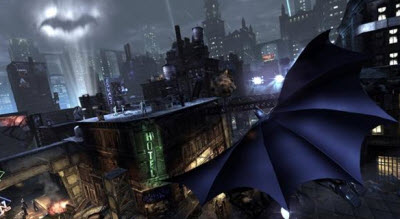 Beyond that, the only in-game “glitch” I experienced was getting stuck in a wall once, and to be fair I was gliding around like an idiot. Batman: Arkham City is surprisingly sound, and an absolute technical marvel in many regards. What Rocksteady has achieved with their drastically enhanced Unreal 3 engine genuinely reveals the brilliance of the Arkham engineers, all of whom have hopefully been given a very large raise. No longer confined within asylum walls, Batman is free to explore Arkham City using his iconic cape and grapple gun, plus his newly found, limited free-running skills (though they thankfully do not play as big a role as the prologue would lead you to believe).
Beyond that, the only in-game “glitch” I experienced was getting stuck in a wall once, and to be fair I was gliding around like an idiot. Batman: Arkham City is surprisingly sound, and an absolute technical marvel in many regards. What Rocksteady has achieved with their drastically enhanced Unreal 3 engine genuinely reveals the brilliance of the Arkham engineers, all of whom have hopefully been given a very large raise. No longer confined within asylum walls, Batman is free to explore Arkham City using his iconic cape and grapple gun, plus his newly found, limited free-running skills (though they thankfully do not play as big a role as the prologue would lead you to believe).
Learning to glide with Batman is relatively painless, though mastering the nuances of flight requires a bit of skill and practice. There are eight augmented reality side missions to put your gliding and dive-bombing abilities to the test, and doing the first four will even reward you with a Grapnel Boost, allowing Batman to gain extra glide with his grapple gun. Eventually, you could glide and dive your way from one end of Arkham City to another, should you be so inclined. And although initially daunting, you’ll soon learn that the game world is not all that large. At least, not the outer areas. You’ll be heading inside and deep below the streets for every major mission. Seamlessly moving from an underground lair that you’ve just spent an hour exploring sans loading times back to the streets of Arkham City is where you realize just how impressive the tech truly is. At the same time, you’ll be doubling back to revisit many of these areas throughout the game. It’s not horribly blatant or recycled, but it’s definitely noticeable nonetheless. There is a misleading sense of scope at work here.
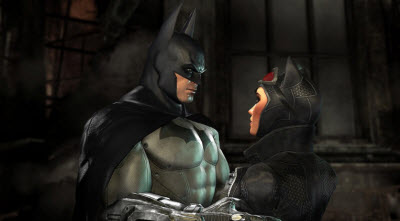 Enhancing the already solid gameplay
Enhancing the already solid gameplay
When not hovering safely above the ongoing turf war between henchmen loyal to various villains, Batman is doing what he does best: hitting bad guys so hard they crap their buddy’s pants. And although it’s fair to say that the Arkham combat engine is similar to that of Assassin’s Creed, I found it eerily reminiscent of Mortal Kombat. Every time I smashed a thug’s face I expected a slow-motion X-ray view of their eyeball popping out. Batman makes a big deal about never killing anyone no matter what, but you can’t tell me he hasn’t inadvertently punctured someone’s lung or snapped a neck with all of his rough-housing.
Fans of the original Arkham will be glad to hear that not much has been changed, only tweaked and improved. One button is used for melee attacks and combos, another for counters, and a third for stuns. Stunning an opponent now allows for a special beatdown assault which rapidly increases the combo meter, unlocking special moves that instantly KO a single enemy, permanently break an enemy’s weapon, or even knock all nearby enemies down. Counters have also been expanded, allowing up to three enemies to be countered at once.
Since Batman will be facing off against considerably larger groups this time around, he’s also been granted a larger arsenal with which to dispense the hurt. Learning to use the various quick fire gadgets at his disposal are key to mastering combat, though I expect the average gamer will never really scratch the surface of what’s possible here. I’ve already seen people complaining about the “dumbed down, two-button gameplay,” which is an outright fallacy.
As you progress through the game, new enemy types will be introduced that require new approaches: armored thugs must be stunned before being attacked, while cattle prod-equipped guards require Batman to flip around behind them. Finally, certain enemies are marked as informants for The Riddler. In order to interrogate them for information, Batman must save them for last during a brawl. This introduces an all-new edge to the combat, as not knocking a specific someone out can be even more dangerous than usual. Once everything the game has to offer is working in tandem, the extremely accessible combat system reveals its true depth.
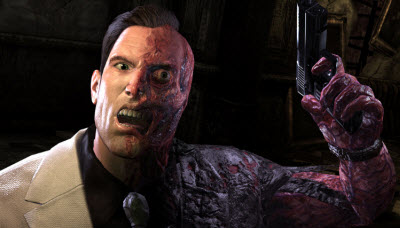 Boss battles have also been revamped, and in general Batman will be able to regularly interact with villains in a more dynamic way. In fact, as seemingly a direct counter to complaints regarding the first game’s by-the-books boss battles, one villain blatantly adapts to Batman’s tactics requiring players to make use of every takedown move at their disposal. Other bosses are a little less open-ended, but none ever feel nearly as rote as the Killer Croc encounter in Batman: Arkham Asylum.
Boss battles have also been revamped, and in general Batman will be able to regularly interact with villains in a more dynamic way. In fact, as seemingly a direct counter to complaints regarding the first game’s by-the-books boss battles, one villain blatantly adapts to Batman’s tactics requiring players to make use of every takedown move at their disposal. Other bosses are a little less open-ended, but none ever feel nearly as rote as the Killer Croc encounter in Batman: Arkham Asylum.
Unfortunately, stealth remains roughly the same as before. That’s not to say it isn’t fun, but for a character notorious for lurking in the shadows, there is an extreme lack of shadows in Arkham City. If this game were a scary movie told from the viewpoint of a thug, someone in the theater would be screaming “Look up! He’s right there!!” every five minutes. What I mean is, and you already know this if you’ve played the previous game, as long as Batman is in a designated safe zone, the AI won’t notice him. That six-foot-tall caped crusader hanging from the gargoyle in plain sight in a well-lit room full of enemies? Completely invisible. The bad guys even start using infrared goggles to check hiding spots, which is as absurd as the season finale of TV show Smallville where no one notices a giant flaming planet hovering in Earth’s atmosphere until it’s picked up on a radar. “Look up! It’s right there!!” The poor presentation of the stealth gameplay is not just detrimental to the game itself, it also has the added effect of making Batman considerably less cool than he really should be. If you’ve ever seen Batman rise up from the shadows behind a panicked thug in a comic, movie, or cartoon, and thought, “Man, that would make for an awesome video game,” you’ll unfortunately have to wait for the next sequel, as there’s none of that here.
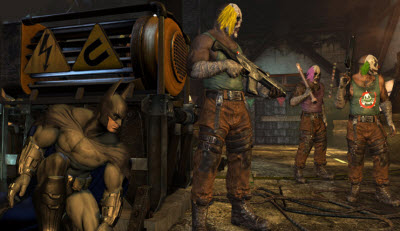 The World’s Greatest Detective
The World’s Greatest Detective
Rocksteady should be commended, as Batman is no simple character to take on. Many have tried, and they either focus too much on his stealth, or his combat, but no one ever really nails the many complexities and talents of Bruce Wayne. To that regard, Batman: Arkham City plays up all of those aspects, with an increased emphasis on detective work. Fear not, as the game hasn’t been transformed into one giant CSI simulator, yet there are many instances where a crime scene is established and Batman must use the Detective Mode view built in to his suit to search for and examine clues. With the help of Alfred, Oracle, and his own intellect, Batman will decipher these leads, so the player sort of takes a backseat to most of the heavy lifting, but that’s where the Riddler comes in.
Like in Arkham Asylum, the Riddler is essentially responsible for Arkham City’s collectibles. Hundreds of Riddler trophies are hidden throughout the game, and again, Rocksteady should be applauded for really going above and beyond what any other game has done to date. Instead of simply finding and picking up a Riddler trophy, players must figure out a simple puzzle, usually involving one or more of Batman’s many gadgets. Some are easy, some are more challenging, but every single one is different. If you look at a rival series such as Assassin’s Creed, which also has tons of collectibles, from feathers to glyphs to flags, they are all accessed the same way. You simply find them and collect them. The same is true of far inferior games as well, so it really is a testament to the quality of Rocksteady’s Arkham titles that each collectible, out of hundreds, is its own puzzle or mini-game. Beyond those, the Riddler also has riddles that must be solved in each location. To do this, you must find the solution in the environment and then scan it with Detective Mode, essentially giving Batman: Arkham Asylum a fun little camera function.
Batman: Arkham City sports roughly 10 hours of main story playtime, but chances are you’ll get sidetracked many times over between the opening and closing credits. There are a handful of intriguing, multi-part side missions to take on, all rooted in the Batman lore. One of the more interesting side missions involves Calendar Man, who you must visit on a specific day once a month (real-time). Each time he will tell you a story about a murder he committed on that day, until you’ve heard all 12 and earned your pitiful 10 achievement points.
Another fine example illustrating the layered side missions in Batman: Arkham City is that of the Payphone Killer. He will call a random payphone which Batman can find and answer, then forces Batman to race across the city to locate another ringing payphone in a set amount of time. If Batman fails, someone dies. Once the second phone has been answered, the murderer retells a story about how he came to be the person he is today, all while Batman attempts to trace the call. This happens over several calls throughout the game, eventually leading to a climax at the killer’s hideout. After playing this game, it’s going to be hard to go back to every other title that still adheres to the “old” way of doing the same exact thing over and over again, ad nauseam. Batman: Arkham City is a very forward-thinking game, and other developers should really, really sit up and take notes. Please.
Long after the side missions are complete, players will still be hunting down Riddler trophies and solving riddles, each one bringing them closer to finding the location of one of Riddler’s hostages. In a semi-Jigsaw-type deal, Edward Nigma has locked away a handful of victims in various devices and chambers designed specifically for the World’s Greatest Detective to solve. Or not, as Riddler has no intentions of playing fairly. These encounters greatly raise the stakes, and give additional motive for collecting all of the Riddler trophies.
The arcade-like Combat and Predator modes make their return in the Riddler’s Revenge. Accessed from the main menu, these various challenges get straight to business, no story needed, and will put players’ skills to the ultimate test. It’s not just about surviving anymore, but rather about performance. Can you string an entire battle with 15 enemies into a single combo? Can you take down each thug in a different way without alerting anyone? The new Campaign challenges are three combat/predator missions back-to-back. Modifiers are also introduced in the Campaign challenges, and although you can assign each one at will, all of them must be used by the end of the challenge. Modifiers include a forced time limit, a protective aura that moves from enemy to enemy over time making them invulnerable, as well as positive modifiers such as super powered attacks that punch through shields or armor and free medals in case you didn’t meet all the requirements of a certain challenge. It’s a very dynamic, challenging and rewarding mode that will give players tons of mileage, especially considering The Riddler’s Revenge modes can be played by Batman, as well as any of the DLC characters such as Catwoman, Robin, Nightwing, and whoever else should come along further down the road. Is it too much to hope for Huntress or Talia al Ghul?
Many fans of Batman: Arkham Asylum have replayed the game at least once, usually on the hardest difficulty. With that in mind, Rocksteady added a New Game Plus feature, but took it an extra step beyond what is found in other games. Unlocked by beating the game on Normal or Hard, New Game Plus is separate from your original campaign, though the two share XP, ability and gadget unlocks, and Riddler trophies/challenges. This wisely allows you to go back and forth, mopping up any collectibles, side missions, or achievements post-game in the original playthrough, while also working towards completing New Game Plus. However, the true genius of New Game Plus is that it remixes the entire game to be more challenging. Enemies are more ferocious and heavily armored straight from the beginning, with different formations than before, and the counter icon no longer appears when an enemy is attacking. After whizzing through the game the first time, I openly welcome the increased difficulty, though I probably should have put more points into my bulletproof plating….
Now, I’ve been waiting this entire review to rant and rave about what I feel is easily the best part of an already amazing game. As you likely know, Catwoman is a playable character available to anyone who buys Arkham City new, or pays an extra $10 to download her as DLC. But unlike Robin/Nightwing, Catwoman is interwoven into the story. If you don’t have her installed, you will miss four playable chapters that give some optional insight into the story of Batman: Arkham City, as well as the game’s sole encounter with Poison Ivy. I’ve seen a lot of reluctance by the public to have Catwoman be a playable character, and I myself was hesitant to pre-emptively celebrate what could easily have been a half-baked attempt to hype up the marketing efforts and fight secondhand sales. Now that I’ve played as her, I have a difficult time switching back to Batman….
Catwoman is the clawed ballerina to Batman’s brutish brawler. As someone who usually chooses the more nimble characters over the sluggish tanks, she’s the perfect character for me. She’s so nimble, in fact, that she can run up behind enemies without being detected. Her animations are masterfully done, simultaneously depicting the part-time villain, sometime-heroine’s seductively sensuality, cat-like grace, and femme fatale brutality. For a game that curiously lacks epic set pieces and high action moments, every fight Catwoman gets into constitutes a watercooler moment. Catwoman displays the game’s most visually compelling and elegant attacks, flipping about acrobatically and using her whip or caltrops to stun enemies before scratching their eyes out. She makes Batman look like a drunken bar room scrapper by comparison.
Lacking the flight abilities of Batman, Catwoman uses her whip to travel the rooftops of Arkham. If point B is too far from point A, she will whip as far as she can and then latch on to the target structure with her claws. A green icon will appear, requiring specific button timing in order to leap to the next spot. Climbing a building can take as many as eight jumps (though it usually averages between 2-4), drastically changing the way the game is played. Thinking about that from a technical standpoint, Rocksteady literally built substantial, all-new mechanics just for Catwoman, and the extra effort has paid off in spades. The Riddler has left trophies specifically for Catwoman as well, though she can also pick up Batman’s. For added entertainment, Selina can don her Animated Series outfit, and is available in the post-game freeroam.
Catwoman adds a whole new world to the Arkham universe. I never thought it possible, but this game has wiped that Halle Berry calamity from my memory banks and instilled a love for the character that I could just never muster until now. I don’t know if I’d feel the same way if this game were called Catwoman: Arkham City, but as is, she is the perfect counterpart to Batman, and goes a long way to making this game an even more well-rounded package.
Massive value for fans of The Bat
Rocksteady has managed to not only create one of the greatest pieces of Batman culture, but has also elevated Catwoman to the upper echelon’s of gaming’s most able-bodied females. Between the wealth of campaign content and Riddler’s Revenge modes, Batman: Arkham City will likely be spinning in my disc drive until The Dark Knight Rises hits theaters next year, and probably long after that given suitable DLC. It’s not a perfect game, but it’s also hard to imagine where Rocksteady can go from here. 89 out of 100.
VentureBeat's mission is to be a digital town square for technical decision-makers to gain knowledge about transformative enterprise technology and transact. Learn More
